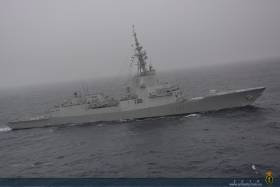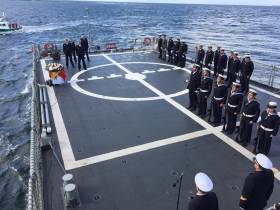Displaying items by tag: Spanish Navy
Spanish Navy Frigate Among NATO Flotilla to Visit Dublin Following Major Exercise off Scotland
#SpainScotland - French Navy ships are currently visiting Dublin Port with more to come among them the Spanish that also participated in Joint Warrior 172, Europe's largest military exercise for some time that had taken place off Scotland, writes Jehan Ashmore.
The UK led multi-national exercise involving some 30 warships from NATO, numerous aircraft, marines and troops had been testing anti-terrorism tactics, piracy, humanitarian missions and other duties. Asides the French and Spanish the multinational flotilla included the Royal Canadian Navy. All these navies are scheduled each to send a frigate to Dublin before next mid-week.
The French will again be represented by FGS Provence, the fourth caller since yesterday. The other frigates are the Canadian Navy's HMCS Montréal and from Spain Álvaro de Bazán. The country on 1st October drew worldwide attention given the independence referendum held in Catalonia. This was in marked contrast as only yesterday, 12th October was the National Day of Spain.
The “Álvaro de Bazán” class frigate belongs to the 31st Escort Squadron based in Ferrol, Corunna in north-west Spain. The frigate was launched locally in Ferrol on October 27th 2000 at the NAVANTIA Shipyards. The frigates motto and coat of arms is “Rey Servido y Patria Honrada” which translates to Served king and Honoured Homeland.
Another referendum but this time on Scottish independence took place in 2014. It was somewhat ironic that the 147m Spanish frigate had called to Glasgow only last week.
The leadship of the Álvaro de Bazán frigate class is of a modern design that according to the Spanish Navy has a remarkable military capability. The frigate is equipped with an AEGIS Combat System that makes the class a most valuable asset at the service of the Nation’s foreign policy, not only in conventional operations, but also in peace-keeping and humanitarian aid missions, enforcement of UN resolutions, etc.
This year, Joint Warrior 172 overlapped with Formidable Shield 17 - a U.S. led joint NATO live fire Integrated Air Missile Defence (IAMD) exercise. Both exercises had provided a complex environment in which allied units trained together in tactics and skills for use in a combined joint task force.
In addition our very own L.E. James Joyce, the second of three OPV90 /Playwright sisters completed, will dock in Dublin on Monday before this contingent of the NATO flotilla arrive. Firstly on Tuesday, HMCS Montréal is scheduled while on Wednesday it will be the turn of both FGS Provence and Álvaro de Bazán.
In the reporting of visiting naval vessels, the schedules can be fluid, so much so that due to operational reasons such ship visits can be swapped around, delayed or even be cancelled.
Visit to Dublin of Spanish Navy Tallship Open to Public Likewise of Former Fleetmate In Glasgow
#OpenTallships - As one of the world’s largest tallships from the Spanish Royal Navy is visiting Dublin Port, Afloat also highlights a former sail trainee from the Iberian nation that is the centrepiece of a Scottish museum, writes Jehan Ashmore.
The five-day visit of the magnificent Spanish Navy tallship to Dublin is by the four-masted Juan Sebastián de Elcano. At 370ft long the barquentine is the world’s third largest tall ship and one of the oldest tall ships dating to 1927 and that is still sailing.
As previously reported on Afloat, the steel-hulled tallship is open to public tours only today (Wednesday 14 June) between 10.00 to 13.00 and 15.30 to 19.00. The tallship is located at Berth 18 just beyond the Tom Clarke (East-Link) Toll-Bridge.
In 1931 the Juan Sebastián de Elcano became part of the Spanish Navy and also that year the Galatea another sail trainee ship was transferred from the Spanish Officers training school to the Spanish Republican Navy.
Glenlee (the former Galatea) is a 275ft long three-masted barque that is also impressive. Equally inspiring is where she is berthed at the multi-award winning Riverside Museum, Glasgow. This striking structure was completed in 2011 to a design by the Iranian born architect, the late Zaha Hadid.
It was during a visit on board Glenlee at the museum on Pointhouse Quay, that a nugget of information sprung out from a display panel that revealed during the clipper cargoship's career trading the oceans had included calling to Cobh, Cork Harbour.
The Glenlee is the original name of the ship named after a villa along the Clyde from she was built in 1896 as a sailing bulk-carrier cargoship from the Bay Yard in Port Glasgow. She was one of 10 steel sailing ships built to a standard design for the Glasgow shipping firm of Archibald Sterling and Co. Ltd. Roll on 121 years and the tallship is the UK’s only floating Clyde-built sailing ship left. The barque is also open to the public as a permanent floating exhibit at the museum's dedicated berth along Pointhouse Quay, the site of a former shipyard.
The barque having circumnavigated the globe four times and survived (though not without incident!) fearsome storms off Cape Horn, was bought by the Spanish Navy in 1922. This saw the ship turned into a sail training vessel and in which remained in that role for several decades until 1981.
Galatea was laid up by the Spanish Navy where in Seville Harbour the largely forgotten barque was spotted by a British naval architect in the southern port in 1990. Two years later, the Clyde Maritime Trust succeeded in acquiring the ship at auction for 5 million Pesetas (£40,000) and saved her from dereliction.
After towage to Scotland, a major restoration project was carried to bring the barque back onto the Clyde and revive her original name of Glenlee. She is one of just 5 Clydebuilt sailing ships that remain afloat in the world thanks to a six year restoration project carried out by the Trust’s paid and voluntary crew.
In November 1999, the Glenlee was recognised as part of the UK’s Core Collection of historic vessels. Chosen from a list of over 1,500 ships, the Glenlee is one of only 43 vessels recognised by the National Historic Ships Committee as being of pre-eminent national significance in terms of maritime heritage, historic associations or technological innovation.
Asides the Glenlee, the surviving quartet of Clydebuilt sailing ships are listed below and to locations of the visitor attractions.
Balclutha (San Francisco)
Moshulu (Philadelphia)
Falls of Clyde (Hawaii)
Pommern (Finland)
The Riverside Museum is also home to over 3,000 objects that detail Glasgow’s rich maritime history as a powerhouse in the early to mid-20th Century. For further information click the museum’s website here.
Spanish Navy Pay Tribute to Armada Fleet off Sligo's Streedagh Beach
#ArmadaEvent - The Spanish Navy held a ceremony in memory of the Armada fleet that brought the 6th annual Celtic Fringe Festival to a close at Streedagh Beach in Sligo on Sunday afternoon.
Tributes were paid on land and at sea to the memory of the 1,100 souls who perished at Streedagh in 1588 when three Armada ships were wrecked during Winter storms.
And while the weather was more benign this afternoon, when intermittent Autumn showers fell on the crowd who gathered at the Armada monument at Streedagh, further out to sea, the Spanish Navy’s OPV Centinela, a fisheries patrol ship, performed a moving tribute to their fallen comrades.
“Today was very special for all of us on board,” said the captain of the Centinela, Lieutenant Commander Miguel Romero Contreras after a poignant ceremony in which he, as senior officer on board, and his most junior seaman, Alvaro Couce, laid a floral wreath on the Atlantic ocean, which had claimed the lives of so many of their countrymen over 4 centuries ago.
A very poignant ceremony has concluded just off shore at Streedagh. The captain of the Spanish navy vessel Centinela has laid a wreath to commemorate the sailors who lost their lives in 1588 when three ships from Spanish Armada sank off the Sligo coast.
“The emotion of a day like this is difficult to put into words,” added the Lieutenant Commander. “Remembering the passing of so many countrymen many years ago far away from home was a very important event for us, and I would like to thank sincerely the people of Sligo for making us feel so welcome here.”
This was the first time a Spanish military vessel had journeyed into Sligo Bay since the ill-fated voyage of the Spanish Armada, when the 3 ships, La Lavia, La Santa Maria de Visón and La Juliana were lost as the Spanish retreated following a failed invasion of England.
Many of the lives were lost as the Spanish sailors, soldiers and merchants tried unsuccessfully to make it to shore, and the subsequent letter, written by one of the survivors, Captain Francisco de Cuellar, to King Phillip II of Spain, provides us with a unique insight into the Ireland of the time.


























































